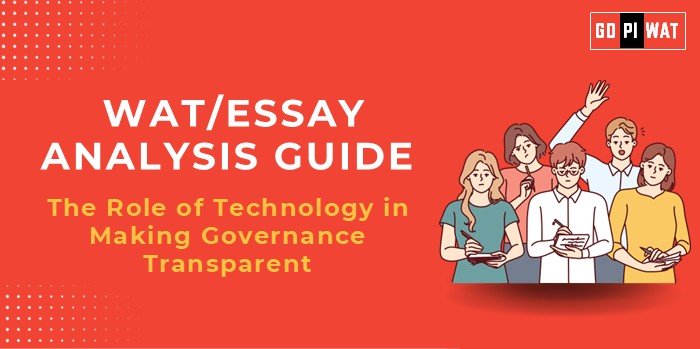📋 WAT/Essay Analysis Guide
🌟 The Role of Technology in Making Governance Transparent
🌐 Understanding the Topic’s Importance
Technological advancements such as blockchain, artificial intelligence (AI), and digital platforms have transformed governance by enhancing transparency, reducing corruption, and fostering accountability. For B-school students, this topic bridges critical domains like policy-making, technology management, and sustainable development—key areas for impactful leadership roles in the future.
📊 Effective Planning and Writing
- Time Allocation:
- Planning: 5 minutes
- Writing: 20 minutes
- Review: 5 minutes
- Preparation Tips:
- Data Collection: Highlight key achievements, such as UPI’s success in enabling transparent financial transactions.
- Identify Challenges: Focus on gaps like limited rural connectivity, cybersecurity risks, and implementation barriers.
- Case Study Inclusion: Use examples like Kerala’s 100% e-governance model and Estonia’s blockchain-driven governance.
🏗️ Structuring the Essay
Introduction Techniques:
- Contrast Approach:
“While India processes over ₹17.5 lakh crore in monthly digital payments, only 20% of rural households have reliable internet access. This stark disparity challenges the goal of transparent and inclusive governance.”
- Timeline Approach:
“From handling 100,000 UPI transactions in 2016 to over 11.5 billion per month in 2024, India’s journey showcases the transformative role of technology in governance.”
Body Paragraphs:
Paragraph 1: Achievements
- Key Points:
- Direct Benefit Transfers (DBT): ₹2.7 lakh crore saved by reducing leakages.
- DigiLocker: 400+ million users streamlining documentation processes.
- Citizen Participation: Platforms like MyGov enable direct public engagement.
- Example: Rajasthan’s “Digital Districts” initiative reduced service delivery time by 45%.
Paragraph 2: Challenges
- Key Points:
- Cybersecurity vulnerabilities: High-profile attacks like the 2022 AIIMS ransomware incident.
- Digital Divide: Only 20% rural internet penetration.
- Limited Digital Literacy: Significant urban-rural knowledge gap.
- Comparison: Estonia’s robust cybersecurity model sets a benchmark.
Paragraph 3: Future Outlook
- Key Points:
- Public-Private Partnerships (PPPs): Foster innovation and infrastructure.
- Blockchain Implementation: Enhance transparency in record-keeping.
- AI in Governance: Predictive analytics for better resource allocation.
Conclusion Templates:
- Balanced Approach:
“While technology has undoubtedly enhanced governance transparency, challenges such as the digital divide and cybersecurity risks must be urgently addressed to ensure long-term sustainability.”
- Future-Oriented Approach:
“With strategic investments in connectivity, digital literacy, and cybersecurity, technology can shape a governance model that is inclusive, accountable, and globally exemplary.”
📖 Sample Short Essays
Balanced Perspective:
“Technological tools like UPI and DigiLocker have made significant strides in governance transparency, reducing corruption and fostering trust. However, these achievements are tempered by issues like limited rural connectivity and the persistent threat of cybersecurity breaches. A balanced approach addressing these gaps will ensure a more inclusive and secure governance framework.”
Solution-Oriented:
“Blockchain and AI represent the next frontier for governance transparency. Blockchain’s immutable ledger can revolutionize public records, while AI’s predictive capabilities enhance decision-making. Prioritizing infrastructure development and digital literacy programs is essential for leveraging these technologies effectively.”
Global Comparison:
“India’s Digital India initiative mirrors Estonia’s e-Governance success by fostering transparency and citizen engagement. However, unlike Estonia, India’s rural connectivity and cybersecurity frameworks require substantial upgrades. Bridging these gaps can position India as a global leader in technology-driven governance.”


